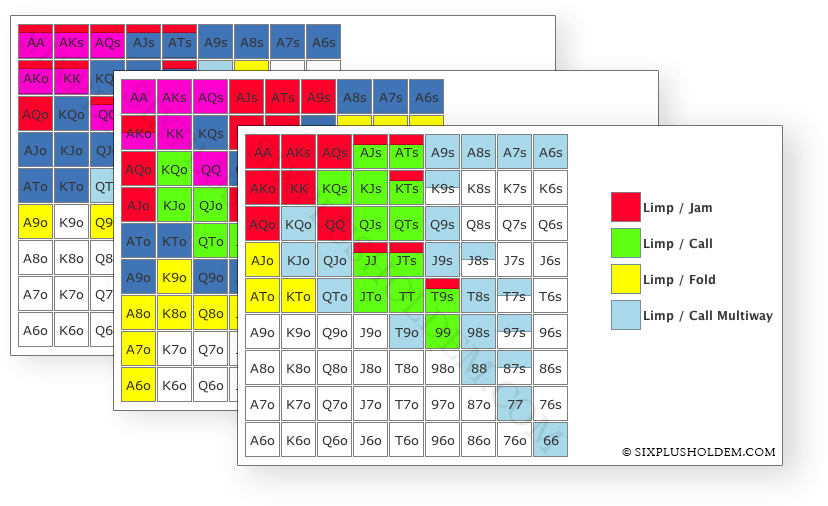Short Deck Poker Best Starting Hands
Posted : admin On 7/16/2022Recently I’ve been hearing about a new game called short deck. It’s played just like normal Texas hold’em, except it’s played with a short deck—all the cards deuce through five are removed from the deck. Aces play as the low end of a nine-high straight. Some variants reorder the hand rankings, most notably changing it so that flushes beat a full house.
- List Of Best Poker Hands
- Short Deck Poker Best Starting Hands In Poker Ranked
- Poker Starting Hand Strength
Poker Hand Rankings - Texas Holdem Starting Hands Chart. At the bottom of this page is a comprehensive listing of Texas Hold'em starting hands based on their EV (expected value). Expected value is the average number of big blinds this hand will make or lose. The worst hand to make in any form of poker is the 2nd best hand, especially in a game such as PLO8 where finding out you are behind can be very expensive indeed. Hands with A-2 and 2 medium cards can be considered marginal, you are unlikely to make a high and are in danger of being quartered when you make the nut low. How to use: First insert the hands and board texture into the appropriate fields using the following format “AhKh” (Where the first (capital) letter represents the card and the second (lowercase) letter represents the suit). When you have the inserted the correctly formatted hands/board texture, hit the play button to run the simulation. PLEASE NOTE: DO NOT use the “6+ short deck” game.
When I first heard about it, it sounded to me like the new math would break a lot of players’ intuition they’ve built playing regular no-limit hold’em. So the first thing I wanted to do was go through how some of the math changes.
Starting ranks and pot odds will be covered soon, but first up, learning the slightly different hand rankings is a must -if you don’t know what wins and loses you’re in big trouble! Because the game is only played with 36 cards instead of the traditional 52 (all the 2’s, 3’s, 4’s and 5’s are removed) there are a few differences to.
Let’s say you get dealt 10h 9h. Let’s go through the math of how often you flop straight and/or flush draws both for normal hold’em and then for short deck.
Full Deck Draws
Once you have your two cards, 50 cards remain in the deck. Three of these will appear on the flop, so there are 50 choose 3 total possible flops. (You can type 50 choose 3 into Google and it will give you the answer.) In this case, that’s 19,600 possible flops.
To flop a flush draw, you need two of the 11 remaining hearts on the flop, as well as an unrelated third card. So that’s 11 choose 2 times 39 (the number of non-hearts remaining in the deck). Since 11 choose 2 is 55, the total number of flush draw flops is 2,145. Divide that by the total number of flops, and you get about 11 percent, which is how often you will flop a flush draw.
To flop an open-ended straight draw you need either Q-J, J-8, or 8-7 on the flop—in each case also with an unrelated card. There are 16 ways to have Q-J (four queens times four jacks), and 16 ways each for the other two for 48 total ways.
If we specify that the unrelated card can’t be one that completes the straight, there are 40 possible unrelated cards for each of the 48 total ways to flop a straight draw. That makes 1,920 total straight draw flops. Divide that by the total number of flops, and you get about 10 percent, which is how often you will flop a straight draw.
Short Deck Draws

In short deck, there are 34 remaining cards after you get your two, so 34 choose 3 or 5,984 possible flops.
There are only 7 remaining hearts, so to flop a flush draw you have 7 choose 2 times 27 possible flops. That’s 567 flops or about 9.5 percent of flops. The full deck chance was 11 percent so flush draws are somewhat less common in short deck.
To flop a straight draw you still have your 48 ways to get Q-J, J-8, or 8-7 on the flop, but now there are only 24 unrelated third cards. That’s 1,152 total straight draw flops or about 19 percent. The chance of flopping a straight draw in short deck is much higher than it is with a full deck.
Making The Draw
Everyone knows the chance to make flush and straight draws in normal hold’em are nine and eight outs respectively. You can use the rule of two and four to estimate the chance of making the draws. But the exact way to figure it out is to do something similar to what we did on the flop. The only twist is you calculate the chance of missing the draw and then subtract that from one.
There are 47 choose 2 possible turn and river cards. That’s 1,081. If you have a flush draw (nine outs) then there are 38 cards that brick your draw, so you have 38 choose 2 ways to miss. That’s 703 total misses out of 1,081, or 65 percent. That leaves a 35 percent chance you hit your flush draw.
Straights work the same, except you have 39 cards that brick your draw. That’s 741 total misses, or 68.5 percent. That leaves a 31.5 percent chance of hitting the draw.
In short deck, there are 31 choose 2 possible turn and river cards. That’s 465. A flush draw has only five outs in this game. So there are 26 cards that brick your draw, and you have 26 choose 2 ways to miss, or 325. That’s about a 70 percent chance to miss, so it’s about a 30 percent chance to make a flush.
Open-ended straights still have 8 outs though. So there are only 23 cards that brick your draw, giving you 23 choose 2 ways to miss, or 253. That’s about a 54.5 percent miss percentage, so you hit your straight about 45.5 percent of the time.
That’s pretty close to 50-50! And you flop a straight draw to your connector nearly 20 percent of the time. Flushes are a bit harder to make in this game, but straights are much easier.
Flopping A Set
The odds of flopping a set change also in short deck. You can figure it out the same way as the chance of making draws—count the flops where you miss the set and subtract from one. With a full deck, there are 48 choose 3 ways to miss your set, or 17,296. That’s about 88 percent of flops, leaving about a 12 percent chance to flop a set.
In short deck, there are 32 choose 3 ways to miss your set, or 4,960 flops. Divide that by the 5,984 total possible short deck flops, and there’s about an 83 percent chance to miss, leaving a 17 percent chance to flop a set.
Final Thoughts
I don’t know how many of us will be playing short deck soon. The game is popular in only a small number of places, mostly in ultra high-stakes cash games. I think one reason it’s become popular in those games is because it turns your ingrained intuitions against you.
When you’ve played hold’em long enough, you begin to internalize the probabilities to make certain hands. You end up getting to the correct answer in many situations through intuition honed over zillions of hands.


List Of Best Poker Hands
Short deck wrecks a lot of those intuitions. The probabilities to make the basic hands are just plain different. Therefore hand values are different. The hands to semi-bluff with and bluff catch with and so on are also different. Blockers mean more in some contexts.
The basic concepts of poker are all the same. But the details of how to resolve conflicts between competing concerns is turned on its head.
Shaking things up in this way always tends to reward the best poker players. The ones who can adjust more quickly than anyone else. The ones who can figure things out rather than rely solely on learned intuition.
Short Deck Poker Best Starting Hands In Poker Ranked
Doing the math in this article is the beginning of this process. ♠
Poker Starting Hand Strength
Ed’s newest book, The Course: Serious Hold ‘Em Strategy For Smart Players is available now at his website edmillerpoker.com. You can also find original articles and instructional videos by Ed at the training site redchippoker.com.